-

人教版新目标初中英语七年级上册My favorite subject is science教案
本单元主要学习一周中星期一到星期天的表达方式;掌握学科的表达;学习用because和表示品质的形容词表示理由;学习what,why,who引导的特殊疑问句。本单元围绕“谈论自己所喜欢的学科”这一话题,设计了三个任务型活动:任务一是:谈论自己所喜欢的学科,学习what引导的特殊疑问句和学科的表达;任务二是:一分钟演讲,让学生介绍自己喜欢某一学科的理由,学习why等特殊疑问句;任务三是:写信,巩固和延伸所学知识,掌握星期的表达方式。单元知识系统(树)What’s your/his/her favorite subject? My/His/Her favorite subject is English.Why do you like math. Because it’s interesting.Why does he/she like art? Because it’s fun.When do you have math? I have math 0n Monday,Wednesday and Friday.What’s Ken’s favorite subject? Science.单元总体目标通过本单元的学习使学生学会谈论自己喜好的学科或自己喜好的其它事情并给出理由;学会说出一周的七天;学会合理地安排自己的作息时间。

人教版新目标初中英语七年级上册What’s this in English教案
一、知识和能力目标本单元的核心教学内容是“认物”。用英语确认周围的常见事物比较符合英语初学者的实际情况。通过本单元教学,使学生运用所学句型,去熟悉周围事物的名称;教学生学会在实际生活中如何确认事物。通过辨认物体,学生学到一些生词,并巩固所学句型。二、过程和方法目标教师要尽量使学生对课文中出现的句型能够熟练上口,这样,学生才能顺利开展比较灵活的对话。教师可以用手势,表情,动作等示意,帮助学生听懂课堂教学内容,但在实际操作中应尽量避免“明知故问”的倾向,应该采用应用性原则;如:遮盖物品、显露局部、辨认物体、完形识别、图形辨认等方法。三、情感态度和价值观目标目标在学生学习过程中的作用至关重要,教师要帮助他们建立起一个切合自己实际的目标,通过渐进的学习以及一点一滴的进步,使他们逐步建立起成功感。成功越多,自信心就越强。

人教版新目标初中英语八年级上册How do you make a banana milk shake教案2篇
1. First, ... then, ... next, ... finally, ...首先,……然后,……接着,……最后,……这是英语中表达做某事的步骤的一种说法。如果步骤较多,还可以说:first-next-after that-later on-finally/at last通常你会听到说英语国家的人在说 first, next, then, finally 和后面的内容时,他们会做一些停顿。这样就能提前告诉听者接下来讲的是一系列的步骤。这一点在朗读和听力中应特别注意。2. how many, how much均为疑问词,同是“多少”,但用法不同。请看:how many修饰可数名词复数,how much修饰不可数名词。但在用法上,同学们常犯如下错误:1) [误] How many are there bananas on the table?[正] How many bananas are there on the table?[析] how many, how much 中的many,much是形容词,常修饰名词作定语,故后面跟名词。2) [误]How much tea are there on the table?[正]How much tea is there on the table?[析] how much修饰不可数名词时,谓语动词用单数。how many与how much的区别可简记为:前how many:问“多少”,复数名词后面跑;how much问“多少”,不可数名词单数好。前者答语用基数词,后者答语用数量关系。

人教版新目标初中英语八年级上册How was your school trip教案2篇
“Go for it!” is based on “Task-Based Language Teaching”. It adheres to “The authenticity principle”, “The form-function principle”, “The task dependency principle” and “The principle of learning by doing”. These principles all accord with the demands of curriculum focus.In and of Grade Seven (II), “Go for it!”, students have learned “The Simple Past Tense”. And it appears again in of Grade Eight (I). teaches students more about how to talk about events in the past. In addition, it gives affirmative and negative statements in the past tense, such as the sentence patterns “Did you see …?” “Were there …?” “Did you go …?” As the first part of Unit 8, Section A opens with a picture presenting the last school trip in the aquarium and continues with several step-by-step practice activities, which are all good for students to master “The Simple Past Tense”. Doing well in Section A will help students integrate the new target language with that in Section B. Thus, they can describe the events in the past freely and foster their own ability of reflecting and practicing. II. Teaching ObjectivesTeaching objective is the beginning and aim of teaching activities. According to the overall goal of the English elementary course--- improve students' synthetic ability of language application, which should be based on the development of students’ “Language knowledge”, “Language skills”, “Character building”, “Learning strategies” and “Cross-cultural awareness”. The teaching objectives are described as follows(I). Knowledge objectivesi. Master the simple past tense of regular and irregular verbsii. Recite the new words and expressions about the last school trip in the aquarium, including their pronunciation and intonation

人教版新目标初中英语八年级上册How do you get to school教案2篇
Step Ⅶ Role play ( Work on 1b)1. First ask two students to read the dialogue to the class.Sa: How do you get to school?Sb: Well, I ride my bike to the subway station. Then I take the subway.2. Now work with a partner.Suppose you use two kinds of transportation to get to school \Hangzhou\Beijing... (bus, train, subway, walking, bike, etc.) Tell how you get there. You may use the phrases in 1a.3. Then ask different pairs of students to present their conversations to the class.Step ⅧListening1. Work on 2a(1) First ask students to read the list of information that Thomas wants to know.…where Nina lives.…how far from school she lives.…how long it takes to get to school.…how she gets to school.…what she thinks of the transportation.(2) Tell students what transportation and bus stop mean.bus stop 汽车站 transportation n. 运送;运输Then tell students we'll hear a recording. Please put a checkmark in front of each thing that Thomas wants to know.(3) Now play the recording for students.( Have students pay attention to the sample answer.) (4) Then correct the answers.

人教版新目标初中英语八年级上册What are you doing for vacation教案2篇
Teaching goals : 1. Words & phrases: babysit ,get back , fishing , rent , think about , decide(on) , tourist etc. 2. How to talk about future plans . 3. 现在进行时表示将来计划或行动. 4. 特殊疑问句(where , when , how long引导) Important and difficult points : Drills :What are you doing for vacation ? I’m watching TV . When are you going ? I’m going … . How long are you staying ? We’re staying for five days . Teaching aids : cards and a tape ,a large wall calendar . Period 1 Teaching procedures : Step 1Leading in1. Free talk . 2. Put up the wall calendar . T: I’m staying home on Saturday (pointing to next Saturday ).Ss repeat . Ss: I’m staying home on Saturday . T: OK. Today we’ll learn how to talk about future plans. Step 2Pre-task SB Page 13 , 1a . 1. Look at the picture carefully and tell what you see in the picture . 2. Write the activities from the pictures in the box and add some more . 3. Practice reading . Step 3While-task1. Using the activities we write in 1a to make conversations .For example :What are you doing for vacation ? I’m visiting my uncle . 2. Pairwork .Practice in pairs . 3. 用第三人称练习对话.

人教版新目标初中英语八年级上册I’m going to be a basketball player教案3篇
教学目标1.知识目标:(1)学习What are you going to be when you grow up?/How are you going to do that?句式。(2)学会用英语描述有关职业的表达法。2.能力目标:(1)能够谈论为实现理想所做出的打算和安排。(2)能够谈论未来自己与他人理想的职业及原因。(3)能用英语描述课余时间的活动安排,最终具备表达综合信息的能力。3.情感目标:新学期到来之际,让他们在学习、体育、饮食、特长、读书等方面制定计划,教育学生合理安排自己的课外生活,思考自己的理想职业及适合自己的职业。教学重点、难点本单元的重点为“be going to”表将来,want to be, what,where, when,how引导的特殊疑问句。难点是语言目标的实现。教材分析本单元以I am going to be a basketball player为话题,共设计了三部分的内容:一、Section A该部分有4个模块。第一模块围绕Do you think these jobs are interesting?这一话题展开思维(1a)、听力(1b)、口语(1c)训练;

人教版新目标初中英语八年级上册What’s the best radio station教案2篇
教学重点和难点:运用所掌握的语言描述,比较不同地点的特点。在练习中学习掌握英语比较级和最高级的用法。课前准备分配小组,每组五至六人。通过上网或翻阅报刊杂志等方法,确定旅游线路,做出基本的旅游计划。教学设计:本节课流程图 学法指导:1.由于这是一堂新课,在教学中应注意面向全体,发挥学生的主体性,引导学生积极参与,激发学生的求知欲和学习积极性,指导学生积极思维,主动获取知识,养成良好的学习方法。逐步学会独立解决问题。总之要尽可能调动学生的非智力因素促进智力因素的发展。教法选择:1.电化教学法2.课堂讨论法3.任务型教学法采用这些方法的目的是为了充分调动学生的学习积极性,使学生变被动学习为主动学习。通过电脑形象的演示,加强印象,提高兴趣,突破难点,提高教学效率,进而增大教学的容量和信息量。充分体现教师为主导,学生为主体的教学原则。

人教版新目标初中英语八年级上册What’s the matter教案2篇
She shouldn’t go to the party tonight.Step7. TaskT: You know, there are lots of problems in our life. If you are a doctor, please tell us how to solve the problem. I will divide you into 9 groups. Please work in groups. And then choose one of you to report your ideas.The following are the problems:I have a toothache.I am hungry. I have a sore throat.I am stressed out. I have a sore back.I am tired. I can’t sleep.I have a cold. I have a headache.Report: If you have a headache, you should go to bed early. You should see the doctor. You should eat some medicine. You shouldn’t wash your face with cold water.You shouldn’t sleep late.You shouldn’t swim.…..T encourages the students to give advice as much as possible.Homework:1. Chose one of the problems, and write down your advice2. Copy the new words这一步是用于热身的,同时也可以让他们复习一部分的表示人体部位的单词,扩充知识.学习语言的过程也是一个不断积累的过程,复习旧知识,增添新知识.通过小游戏,强化学生对Does she/he have…这个句子的运用能力.通过复习,自然的引到下面新知识的学习。充分利用表格,由句子到对话,再到文章,让学生循序渐进. 提高学生的综合语言运用能力,运用以前学过的知识来解决身边的问题.Period 5 (Section B 3a—3c, selfcheck)教学内容与分析:

人教版新目标初中英语八年级上册Can you come to my party教案3篇
Step 3 (3b)First, tell the students when we talk about our future plans, we often use: I’m+verb+ing When we talk about what we must do, we use have to. Ask the students to fill in the blanks in 3b. The answers are: shopping, go to see, a test, I’m going, my family. Step 4 (3c)Let the students write an e-mail message to a friend. Say why you can’t visit next. Before the exercise, ask the students to give some possible answers and write them on the blackboard. So the students will feel easy to finish the writing exercise. After they finish it, Let them to correct it in groups first. Each group chooses theirs best one to read in front of the whole class. Step 5 ( planning a party )First read the conversation in the box together. Then ask the students to turn to page 88.Write down everything you have to do next week. Write in all the things you have to do . Ask the students to look at the list. Ask them “What day are you free?” This is when you can have your party. Step 6 (Self check 1 )Let the students to fill in the blanks with the words given. Change the forms of the words if possible. Then make their own sentences. The answers are: visit, playing, have to, study, comeStep 7 (Self check 2)Imagine you are Marie. Read the information and look at your schedule. Write replies to the invitation.
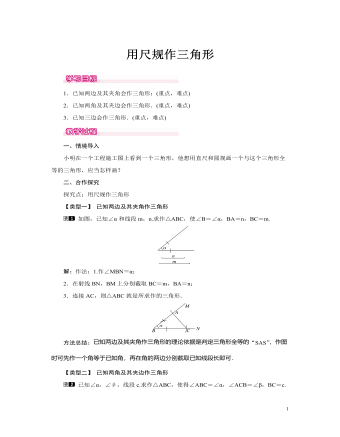
北师大初中七年级数学下册用尺规作三角形教案
【类型三】 已知三边作三角形已知三条线段a、b、c,用尺规作出△ABC,使BC=a,AC=b、AB=c.解:作法:1.作线段BC=a;2.以点C为圆心,以b为半径画弧,再以B为圆心,以c为半径画弧,两弧相交于点A;3.连接AC和AB,则△ABC即为所求作的三角形,如图所示.方法总结:已知三角形三边的长,根据全等三角形的判定“SSS”,知三角形的形状和大小也就确定了.作三角形相当于确定三角形三个顶点的位置.因此可先确定三角形的一条边(即两个顶点),再分别以这条边的两个端点为圆心,以已知线段长为半径画弧,两弧的交点即为另一个顶点.三、板书设计1.已知两边及其夹角作三角形2.已知两角及其夹边作三角形3.已知三边作三角形本节课学习了有关三角形的作图,主要包括两种基本作图:作一条线段等于已知线段,作一个角等于已知角.作图时,鼓励学生一边作图,一边用几何语言叙述作法,培养学生的动手能力、语言表达能力
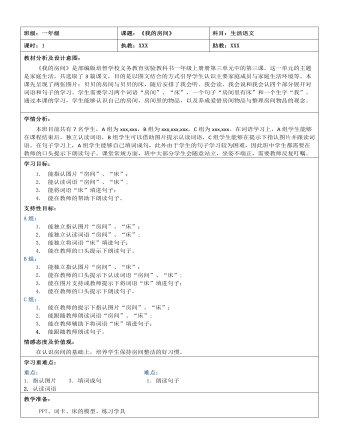
《我的房间》第一课时教案
一、情景导入,引出新知师:“上节课,奇奇妙妙邀请我们去参观了他们的家。这节课,又是哪个小朋友要邀请我们去参观他的家呢?”[出示xxx的照片]师:“这节课是xxx邀请我们去参观他的家。xxx,你要带我们去哪里看一看呢?”[PPT展示xxx家的阳台、房间和网络上的花园图片]<xxx指出自己的房间>师:“这节课,我们和xxx一起去参观房间。”[出示课题:10.我的房间]<学生跟读课题>二、循序渐进,程序教学(一)学习词语:房间[出示图片:房间]“xxx的房间是什么样子的?”“我们请xxx来介绍一下自己的房间。”(教师带领xxx说一说自己的房间有什么:大床、小床、电视)“这个有床、有电视,可以睡觉休息的地方就是房间。”[出示词卡:房间]
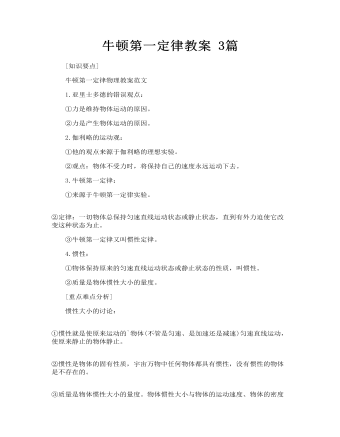
牛顿第一定律教案 3篇
①他的观点来源于伽利略的理想实验。 ②观点:物体不受力时,将保持自己的速度永远运动下去。 3.牛顿第一定律: ①来源于牛顿第一定律实验。 ②定律:一切物体总保持匀速直线运动状态或静止状态,直到有外力迫使它改变这种状态为止。
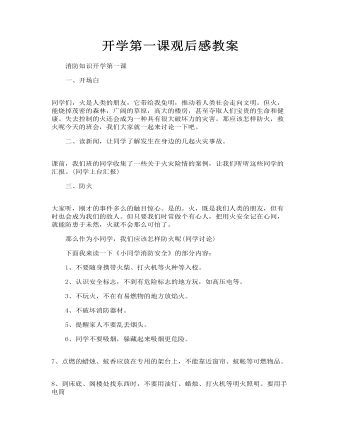
开学第一课观后感教案
三、防火 大家听,刚才的事件多么的触目惊心。是的。火,既是我们人类的朋友,但有时也会成为我们的敌人。但只要我们时常做个有心人,把用火安全记在心间,就能防患于未然,火就不会那么可怕了。 那么作为小同学,我们应该怎样防火呢(同学讨论) 下面我来读一下《小同学消防安全》的部分内容: 1、不要随身携带火柴、打火机等火种等入校。 2、认识安全标志,不到有危险标志的地方玩,如高压电等。 3、不玩火,不在有易燃物的地方放焰火。 4、不破坏消防器材。 5、提醒家人不要乱丢烟头。 6、同学不要吸烟,躲藏起来吸烟更危险。
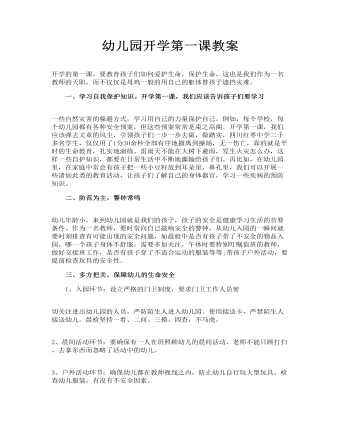
幼儿园开学第一课教案
二、防范为主,警钟常鸣 幼儿年龄小,来到幼儿园就是我们的孩子,孩子的安全是健康学习生活的首要条件。作为一名教师,要时常向自己敲响安全的警钟,从幼儿入园的一瞬间就要时刻排查有可能出现的安全问题,如晨检中是否有孩子带了不安全的物品入园,哪一个孩子身体不舒服,需要多加关注,午休时要特别叮嘱值班的教师,做好交接班工作,是否有孩子穿了不适合运动的服装等等;带孩子户外活动,要提前检查玩具的安全性。
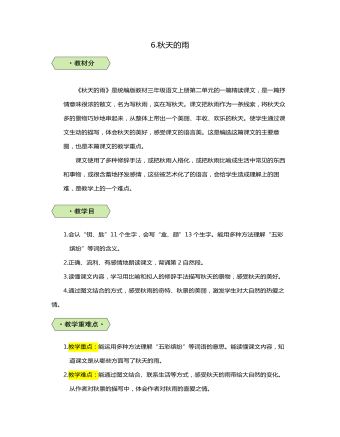
秋天的雨教案
《秋天的雨》是统编版教材三年级语文上册第二单元的一篇精读课文,是一篇抒情意味很浓的散文,名为写秋雨,实在写秋天。课文把秋雨作为一条线索,将秋天众多的景物巧妙地串起来,从整体上带出一个美丽、丰收、欢乐的秋天。使学生通过课文生动的描写,体会秋天的美好,感受课文的语言美。这是编选这篇课文的主要意图,也是本篇课文的教学重点。课文使用了多种修辞手法,或把秋雨人格化,或把秋雨比喻成生活中常见的东西和事物,或很含蓄地抒发感情,这些被艺术化了的语言,会给学生造成理解上的困难,是教学上的一个难点。
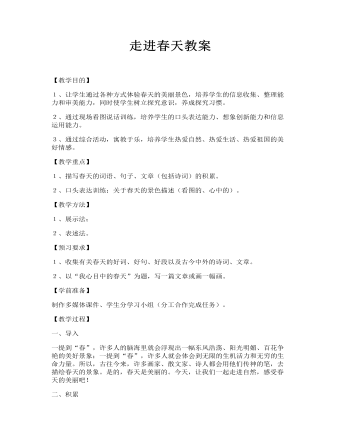
走进春天教案
【教学重点】1、描写春天的词语、句子、文章(包括诗词)的积累。2、口头表达训练:关于春天的景色描述(看图的、心中的)。【教学方法】1、展示法;2、表述法。【预习要求】1、收集有关春天的好词、好句、好段以及古今中外的诗词、文章。2、以“我心目中的春天”为题,写一篇文章或画一幅画。
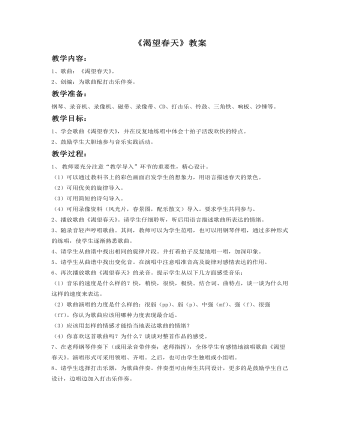
《渴望春天》教案
1、教师要充分注意“教学导入”环节的重要性,精心设计。(1)可以通过教科书上的彩色画面启发学生的想象力,用语言描述春天的景色。(2)可用优美的旋律导入。(3)可用简短的诗句导入。(4)可用录像资料(风光片,春景图,配乐散文)导入。要求学生共同参与。2、播放歌曲《渴望春天》。请学生仔细聆听,听后用语言描述歌曲所表达的情绪。3、随录音轻声哼唱歌曲。其间,教师可以为学生范唱,也可以用钢琴伴唱,通过多种形式的练唱,使学生逐渐熟悉歌曲。4、请学生从曲谱中找出相同的旋律片段。并打着拍子反复地唱一唱,加深印象。5、请学生从曲谱中找出变化音。在演唱中注意唱准音高及旋律对感情表达的作用。6、再次播放歌曲《渴望春天》的录音。提示学生从以下几方面感受音乐:(1)音乐的速度是什么样的?快,稍快,很快,极快。结合词、曲特点,谈一谈为什么用这样的速度来表达。
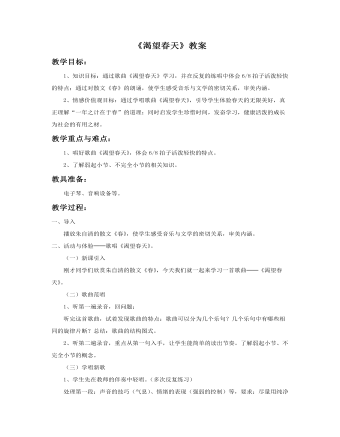
《渴望春天》教案
一、导入 播放朱自清的散文《春》,使学生感受音乐与文学的密切关系,审美内涵。二、活动与体验──歌唱《渴望春天》。 (一)新课引入 刚才同学们欣赏朱自清的散文《春》,今天我们就一起来学习一首歌曲──《渴望春天》。 (二)歌曲范唱 1、听第一遍录音,回问题: 听完这首歌曲,试着发现歌曲的特点:歌曲可以分为几个乐句?几个乐句中有哪些相同的旋律片断?总结:歌曲的结构图式。 2、听第二遍录音,重点从第一句入手,让学生能简单的读出节奏。了解弱起小节、不完全小节的概念。 (三)学唱新歌 1、学生先在教师的伴奏中轻唱。(多次反复练习) 处理第一段:声音的技巧(气息)、情绪的表现(强弱的控制)等,要求:尽量用纯净的声音唱出艺术歌曲的感觉。

《春天来了》教案
一、歌曲导入 播放歌曲《布谷》。师:这首歌曲好听吗?请大家想一想,歌曲歌颂的对象是什么?歌曲的情绪是怎样的?学生讨论后回答。二、新授歌曲《春天来了》。1、学生听范唱,回答问题。师:请同学们再听一首歌,你能听出歌曲的歌颂对象是什么?情绪是怎样的?2、用“啦”字哼唱全曲。师:你发现那些地方容易哼错需要注意的?3、教授断音记号,请学生把歌谱完整地唱一遍。师:我们一起来唱整首歌曲的歌谱,注意断音记号,要唱得短促有弹性。舌尖的动作要敏捷轻巧。4、唱歌词。师:歌曲的情绪是怎样的,该用怎样的声音来表现呢?学生思考后知道该用有弹性的声音来唱,再唱一唱。5、改变速度演唱《春天来了》体会情绪的转变。师:同学们的声音真好听,我已经闻到了春天的气息,现在你跟我的琴声唱一唱体会歌曲的情绪是否发生了变化?用连音法唱。6、学生用较慢的速度唱体会歌曲的情绪,体会情绪,然后讨论回答问题。师:同学门说的很好,速度的变换影响歌曲的情绪,只要符合歌颂的对象,我们在唱歌的时候,也可以改变一下速度,让一首歌曲唱出几种味道来。